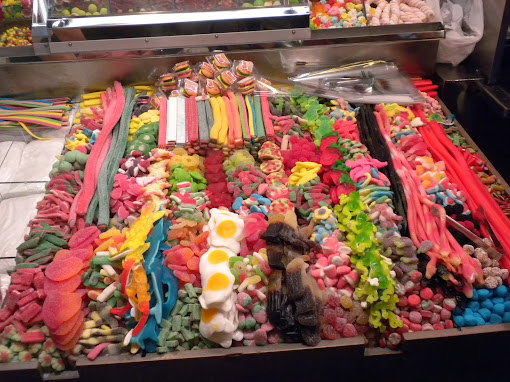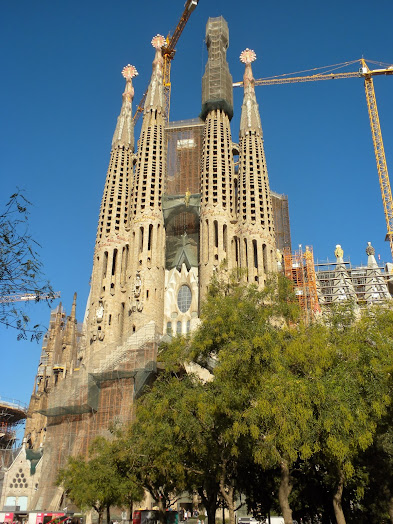Carol writes:
BARCELONA: After we left Italy, we did a 3-day speed-run across southern
France to the Spanish border, then headed down to Barcelona for our first stop. We were treated to a warm and sunny day for
our walk down Barcelona’s well-known Ramblas, a wide and busy pedestrian
walkway through the heart of the city.
The
highlight of the Ramblas walk was ‘La Boqueira’ covered market where enticing
food and drink displays were a delight to the eye.
Other than
people-watching, we found Barcelona rather uninteresting (i.e. little old-town
character), just a very large modern city, very different from most of our
other European travel destinations. Our
final stop for the day in Barcelona was at ‘La Sagrada Familia’, a giant
unfinished church that has been under construction for 130 years!
MADRID: The next day we drove into the heart of the Spanish
countryside to Madrid, the capital and geographic center of Spain. We were amazed at the very high quality of
the secondary divided highways that we drove along. Signage was excellent and design was very
similar to the U.S. highway system. We
actually made very good time along these roads, which was a pleasant surprise, knowing
we had about 350 miles to cover to get to Madrid. I loved the giant bull silhouettes that
popped up periodically along the route to Madrid.
From our
vantage point along the highway, Spain looked to be a very rich country in
terms of agriculture, with almost every acre under cultivation with either olive
groves or vineyards. However, as we neared
the cities and looked closer, we could find evidence of Spain’s woeful economic
problems—many large shuttered businesses, frequent abandoned construction
projects, and, in the cities, lots of street entertainers and beggars trying to
eke out a few euros from passersby.
Madrid was
much like Barcelona, a large modern city very unlike much of the rest of Europe. Large cities tend to have big problems when
things go wrong, and Madrid was no exception.
Apparently, the city was a few days into a strike by its sanitation
workers. Trash was everywhere! Trash cans were overflowing! Such a stark contrast to Barcelona where the
streets were neat and clean…
We had two planned
destinations in Madrid. The first was
the Royal Palace, one of the most sumptuous palaces in all of Europe and home
to Spanish royalty since the 17th century.
We were
beginning to realize that at most of Spain’s premier attractions indoor photos
would not be allowed, as was the case at the Royal Palace. However, the Internet had plenty of those
forbidden indoor shots, so I have resorted to posting a few. The palace rooms were beyond lavish,
with incredible
porcelain walls in one small room,
and the
world’s best collection of Stradivarius instruments in another.
The second
reason we wanted to visit Madrid was for the opportunity to visit the Prado
Museum, known for having one of the world’s greatest collections of European
paintings. We were in Spain…so the Prado’s
collection was marvelously heavy on paintings by El Greco, Goya, and Velázquez. Two of our favorites…
‘The
Parasol’ by Goya
‘Las Meninas’ by Velázquez, one of the finest paintings in the art world
Doing a
daylong museum crawl can be one of the most exhausting kind of walks, but we
both felt that the Prado was worth it.
We finished
out our day in Madrid at a popular overlook where, apparently, it was custom to
gather for sunset.
NEAR MADRID:
From Madrid it was a short drive the next day into the surrounding hills
where we had two destinations in mind.
In the morning we visited the reflective ‘Valley of the Fallen’, Spain’s
somber stony monument to the 500,000 victims (on both sides) who lost their
lives in the Spanish Civil War (1936-1939).
The 450-foot cross that sat atop the underground basilica was
impressive.
The basilica
itself (no photos allowed) was quite lovely in a stark kind of way.
Al and I
both felt that this monument was a splendid and appropriate memorial to a very
sad time in Spanish history.
After
checking into a nearby campground, in the afternoon we took a bus into the city
to visit the Monastery of San Lorenzo at El Escorial, a 16th century
combination palace/monastery from where Philip II directed the Spanish
Inquisition.
The
beginning of the tour was ho-hum…until we reached the royal mausoleum which
housed the remains of 26 Spanish kings and queens over 4 centuries! No pictures were allowed (of course), but it
was a ‘wow moment.’
Identical
royal coffins were stacked ‘4 high’ in niches along the wall of a grandiose circular
room. How did these pics from the
Internet ever get taken?
TOLEDO: The next day we spent a short time in Toledo visiting the famous
Toledo Cathedral. By now, we had visited
many of Europe’s magnificent churches, so I think I can say with some
credibility that the Cathedral of Toledo just didn’t meet our expectations…I
found it rather disjointed in style and design, although I must admit that the
altar area was grandiose.
In closing,
our first impression of the great cities of Spain was a very favorable one,
although it was a surprise to us that Barcelona and Madrid appeared so
modern. Before the worldwide economic
downturn, Spain must have undergone a couple of decades of a tremendous
building boom. Hopefully, the Spanish
economy recovers soon because, to our eyes, Spain appeared to have so much
potential. We have certainly been
enjoying its marvelous off-season climate.
No wonder so many northern Europeans come to Spain to spend the
winter. Now we are anxious to visit some
of Spain’s smaller southern cities where we can get a look at some wonderful
Moorish history and architecture. On to
Cordoba and Granada!
“He who does
not travel does not know the value of men.”
Moorish proverb







.jpg)
.jpg)
.jpg)
.jpg)
.jpg)


.jpg)


.jpg)

No comments:
Post a Comment